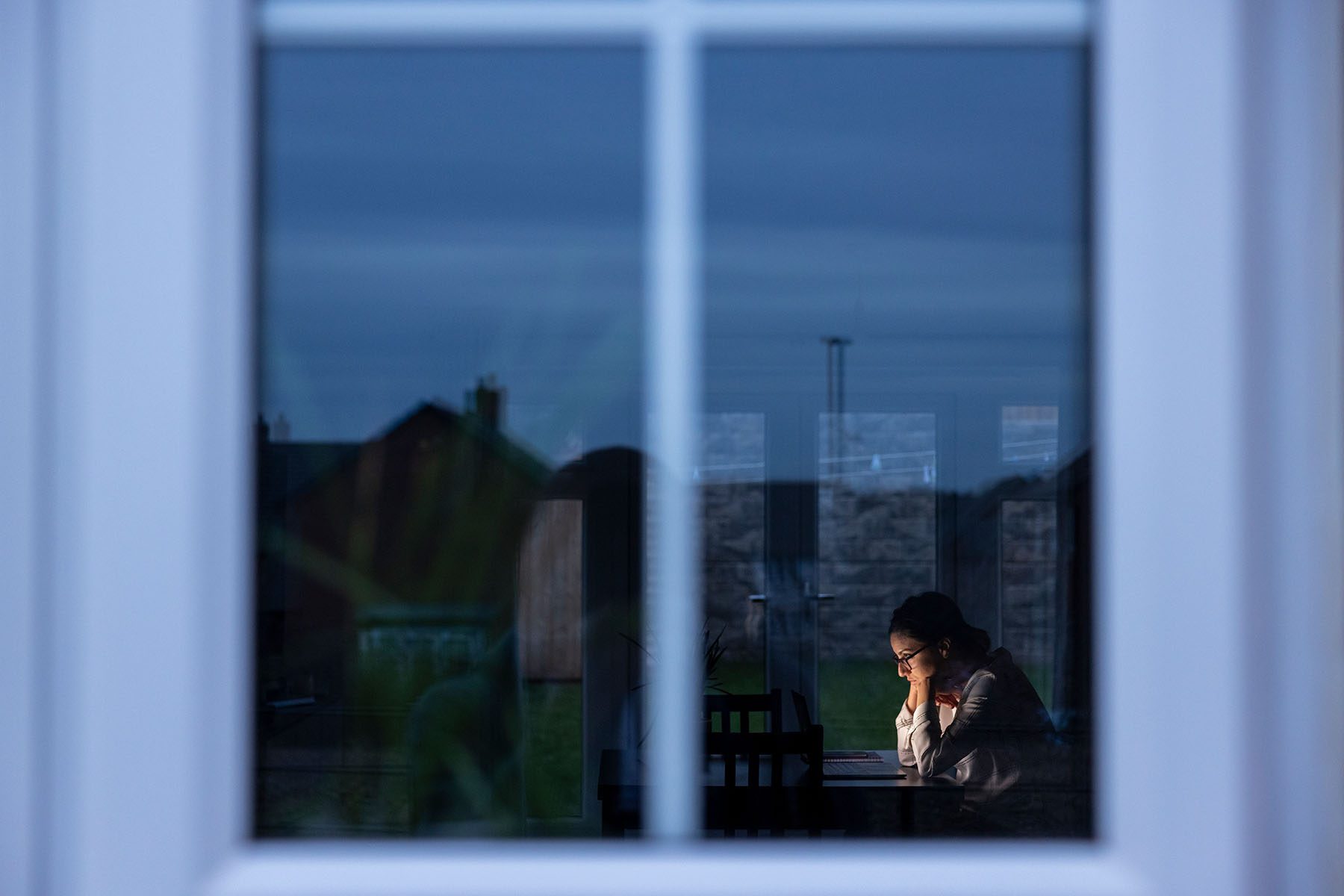In April, it hit Robin hard. I don’t want to get out of bed, she thought. I’m exhausted. Nothing matters.
The mother of three from Washington, D.C., was both physically and emotionally drained. Over the past year, she had seen her professional workload almost double, in large part thanks to the logistical challenges involved in doing her job from home during the pandemic. April — when COVID-19 vaccines were finally becoming more available — should have been a moment of relief. But it wasn’t.
“I was like, ‘Oh there’s a light at the end of the tunnel. And then no, no, no — there was no light at the end of the tunnel,” said Robin, who asked that her full name be withheld because she did not want to discuss her mental health publicly.
Robin, who is in her 40s, decided she needed help, so she asked everyone she knew for recommendations. Finally, she found what she was looking for: a therapist who could see her virtually, and who was accepting new patients. Virtual care made therapy available to her in a way going in person did not. She could see someone from her bedroom, rather than try to squeeze in a visit across town in the middle of a workday.
Since spring, she’s been seeing her therapist every other week through a video platform she can use from home — a solution increasing numbers of mothers appear to be adopting as the threat of COVID-19 lingers and a “return to normal” appears still elusive. For Robin, it’s done a world of good. Her workload hasn’t changed, but she’s learned how better to manage the stress of parenting young children through a pandemic, and the anxiety she feels about balancing parenthood and work.
“I should have done it a year before,” she said. “These are incredibly stressful times. It’s a long slog with all kinds of challenges — new challenges and old challenges.”
Since March 2020, the COVID-19 pandemic has exerted a heavy and uneven psychiatric toll. Symptoms of anxiety and depression — conditions that were already more prevalent among women than men — spiked. Women, who during the pandemic were more likely to navigate increased child care responsibilities and to face job loss as a result, reported higher rates of both conditions.
In July 2020, about 44 percent of women said they had experienced symptoms of depression or anxiety, compared to 36 percent of men, per data collected by the Centers for Disease Control and Prevention. This past March, around when Robin began seeking out her own mental health care, rates remained fairly high: 40.5 percent of women and 33.1 percent of men reported symptoms of either condition.
Even now, as CDC data suggests rates of anxiety and depression may finally be falling from that pandemic peak, the gender gap has persisted. By October — the most recent period for which the agency has information — 35.3 percent of women said they had experienced symptoms of depression or anxiety, compared to 27.5 percent of men. (The CDC does not break out symptoms for nonbinary people, but has as of this summer started collecting information comparing transgender people to cisgender ones: Rates of both anxiety and depression persist at higher rates for transgender people.)
“If you even look at the baseline rate for anxiety and depressive disorders for women compared to men in their reproductive years, women are twice as likely to get anxiety and depressive disorders,” said Dr. Elizabeth Fitelson, who heads the women’s program at the Columbia University psychiatry department. “And then you throw in the pandemic.”
Virtual care has been touted as a possible solution, with health care providers arguing that it’s the safest way for patients to continue getting needed care, and industry analysts suggesting the telehealth industry at large could be worth billions of dollars in a post-COVID reality. In a paper published this past spring, researchers at the National Partnership for Women and Families suggested that there could be acute benefits for women in particular — who are more likely than men to visit a mental health care provider, but also more likely to have lower incomes and child care barriers that make it difficult to visit a doctor. Those barriers were exacerbated by the COVID-19 pandemic.
Because of COVID-19 , the federal government has moved since 2020 to loosen its regulations for telemedicine, theoretically making it easier for people to see therapists from home. Providers can bill insurance for visits done over the internet, and even for check-ups over the phone, though how much such visits should be reimbursed remains a subject of heated policy debate.
The full picture is still coming in. CDC data suggests that women are more likely than men to have had a virtual health care visit within the past four weeks, though it does not break out mental health specifically. But in interviews with The 19th, mental health care providers said their patient base has increased substantially in the past year, and switched to almost entirely virtual visits.
For parents — particularly for working mothers — that flexibility could be powerful. It means not needing to arrange for child care, not having to take extra hours from work to drive across town or secure transportation for mental health care. Policy experts say those barriers disproportionately affect women when it comes to accessing any kind of health care, mental health or otherwise.
But at the same time, policy experts and doctors alike worry that the shift to virtual it isn’t enough.
For one, finding a provider who accepts insurance (and that’s if potential patients even have it) remains difficult at best. Consistent telehealth also requires having a regular, reliable internet connection, a consistent phone number to use, and safety and privacy in one’s home. None of those are guarantees.
“There are people accessing care regularly more now than they would have been able to before, but of course there are inequities,” Fitelson said.
Robin’s insurance doesn’t cover her appointments, for example. But between her salary and her husband’s, she decided she could afford the care. In that regard, she knows she’s fortunate.
“We’re lucky, because we’re both employed and making good money, and can cover this. “But for people who can’t?” she said. “We’re not doing this right as a society. We’re not.”
Seeing people over the phone or on video chat means mental health specialists are able to see more patients more efficiently, multiple psychiatrists and other providers said. There are fewer no-shows, and there is less time between patients.
Meanwhile, the nation’s mental health care system remains fragmented and understaffed. The marginal increase in efficiency isn’t enough to accommodate the mammoth upswell in people experiencing signs of mental distress — especially since there already weren’t enough specialists to treat everyone seeking mental health care.
“Telehealth has expanded access.There are more options for getting mental health services and any sort of health care services. But wait times for mental health care are still ridiculous,” said Brittni Frederiksen, a senior policy analyst for women’s health policy at the nonprofit Kaiser Family Foundation. “It’s always been that way. Nothing has changed with regard to that.”
In 2020, despite the increase in mental health care needs, only about 1 in 4 women received any kind of mental health treatment, according to data analyzed by the CDC. About 12 percent received therapy, and 21 percent some kind of medication. Those numbers represent no statistically significant change from 2019.
The agency has not yet collected data on women’s mental health care usage this year, and the numbers do not break out who received care in -person versus who used a virtual platform.
What the agency’s figures do indicate is a health system that was unable to expand services to scale, even as need has shot up, experts said.
“Telemedicine — it can’t address a dramatic shortage of providers,” said Erin MacKay, managing director for health justice at the National Partnership for Women & Families. “People are still going to be competing for the same small pool of mental health professionals.”
Fitelson said she worries about the implications — for both providers and patients. Mental health professionals too are facing longer patient lists than they can get through. She will see patients for six hours straight, only taking breaks to go to the bathroom. “That’s not sustainable either,” she said.
And the full psychological effects of the COVID-19 pandemic are only now emerging, she worries. The ramifications could last for years.
“This is the beginning of the mental wave,” she said. “In a disaster, the psychological footprint is larger than the thing itself. The mental health wave — we’re in it. It’s just starting.”







